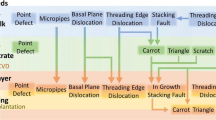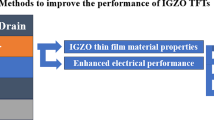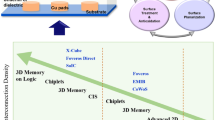Abstract
Thermal stress issues in a three-dimensional (3D) stacked wafer system were examined using finite-element analysis of the stacked wafers. This paper elucidates the effects of the bonding dimensions on mechanical failure and the keep-away zone, where devices cannot be located because of the stress in the Si. The key factors in decreasing the thermal strain were the bonding diameter and thickness. When the bonding diameter decreased from 40 μm to 12 μm, the equivalent strain decreased by 83%. It is noteworthy that the keep-away zone also decreased from 17 μm to zero when the bonding diameter decreased from 40 μm to 12 μm. When the bonding thickness doubled, the equivalent strain decreased by 44%. The effects of the dimensions and arrangement of through-silicon vias (TSV) were also analyzed. Small TSV diameter and pitch are important to decrease the equivalent strain, especially when the amount of Cu per unit volume is fixed. When the TSV diameter and pitch decreased fourfold, the equivalent strain decreased by 70%. The effects of TSV height and the number of die stacks were not significant, because the underfill acted as a buffer against thermal strain.
Similar content being viewed by others
References
D.J. Frank, R.H. Dennard, E. Nowak, P.M. Solomon, Y. Taur, and H.S.P. Wong, Proc. IEEE 89, 259–287 (2001).
L. Xue, C.C. Liu, H.S. Kim, S. Kim, and S. Tiwari, IEEE Trans. Electron Dev. 50, 601–609 (2003).
S.F. Al-Sarawi, D. Abbott, and P.D. Franzon, IEEE Trans. Compon. Packag. Manuf. Technol. B 21, 2–14 (1998).
J.C. Lin, W.C. Chiou, K.F. Yang, H.B. Chang, Y.C. Lin, E.B. Liao, J.P. Hung, Y.L. Lin, P.H. Tsai, Y.C. Shih, T.J. Wu, W.J. Wu, F.W. Tsai, Y.H. Huang, T.Y. Wang, C.L. Yu, C.H. Chang, M.F. Chen, S.Y. Hou, C.H. Tung, S.P. Jeng, and D.C.H. Yu, Electron Devices Meeting (IEDM), 2010 IEEE International (2010), pp. 2.1.1–2.1.4.
K.H. Lu, X. Zhang, S.K. Ryu, J. Im, R. Huang, and P.S. Ho, Proceedings of Electronic Components and Technology Conference (San Diego, CA, 2009), pp. 630–634.
S.-K. Ryu, K.-H. Lu, X. Zhang, J.-H. Im, P.S. Ho, and R. Huang, IEEE Trans. Dev. Mater. Reliab. 11, 35–43 (2011).
R.R. Reeber and K. Wang, Mater. Chem. Phys. 46, 259–264 (1996).
M.B. Bever, Encyclopedia of Materials Science and Engineering (Oxford: Pergamon, 1986).
P. Dixit, S. Yaofeng, J. Miao, J.H.L. Pang, R. Chatterjee, and R.R. Tummala, J. Electrochem. Soc. 155, H981 (2008).
X. Liu, Q. Chen, P. Dixit, R. Chatterjee, R.R. Tummala, and S.K. Sitaraman, Proceedings of Electronic Components and Technology Conference (San Diego, CA, 2009), pp. 624–629.
P.A. Miranda and A.J. Moll, Proceedings of Electronic Components and Technology Conference (San Diego, CA, 2006), pp. 844–848.
N. Ranganathan, K. Prasad, N. Balasubramanian, and K.L. Pey, J. Micromech. Microeng. 18, 075018 (2008).
C.S. Selvanayagam, J.H. Lau, X. Zhang, S.K.W. Seah, K. Vaidyanathan, and T.C. Chai, Proceedings of Electronic Components and Technology Conference (Lake Buena Vista, FL, 2008), pp. 1073–1081.
S.E. Thompson, G.Y. Sun, Y.S. Choi, and T. Nishida, IEEE Trans. Electron Dev. 53, 1010–1020 (2006).
C. Okoro, Y. Yang, B. Vandevelde, B. Swinnen, D. Vandepitte, B. Verlinden, and I. De Wolf, 2008 IEEE International Interconnect Technology Conference, IITC (Burlingame, CA, 2008), pp. 16–18.
G. Ramakrishna, F. Liu, and S.K. Sitaraman, Proceedings of Electronic Components and Technology Conference (San Diego, CA, 2002), pp. 439–445.
J. Zhang, M.O. Bloomfield, J.Q. Lu, R.J. Gutmann, and T.S. Cale, Microelectron. Eng. 82, 534–547 (2005).
A.M.H.K.H. Hellwege, Landolt–Bornstein: Numerical Data and Functional Relationships in Science and Technology, Group III: Vol. 1 (New York: Springer, 1966).
G.B.B.E.A. Brandes, Smithells Metals Reference Book, 7th ed. (Oxford: Buttterworth-Heinemann, 1999).
L. Chen, Q. Zhang, G.Z. Wang, X.M. Xie, and Z.N. Cheng, IEEE Trans. Adv. Packag. 24, 17–24 (2001).
C.J. Smithells, Metals Reference Book, Vol. III (Butterworths, London, 1967), pp. 686–708.
Author information
Authors and Affiliations
Corresponding author
Rights and permissions
About this article
Cite this article
Hwang, SH., Kim, BJ., Lee, HY. et al. Electrical and Mechanical Properties of Through-Silicon Vias and Bonding Layers in Stacked Wafers for 3D Integrated Circuits. J. Electron. Mater. 41, 232–240 (2012). https://doi.org/10.1007/s11664-011-1767-x
Received:
Accepted:
Published:
Issue Date:
DOI: https://doi.org/10.1007/s11664-011-1767-x




